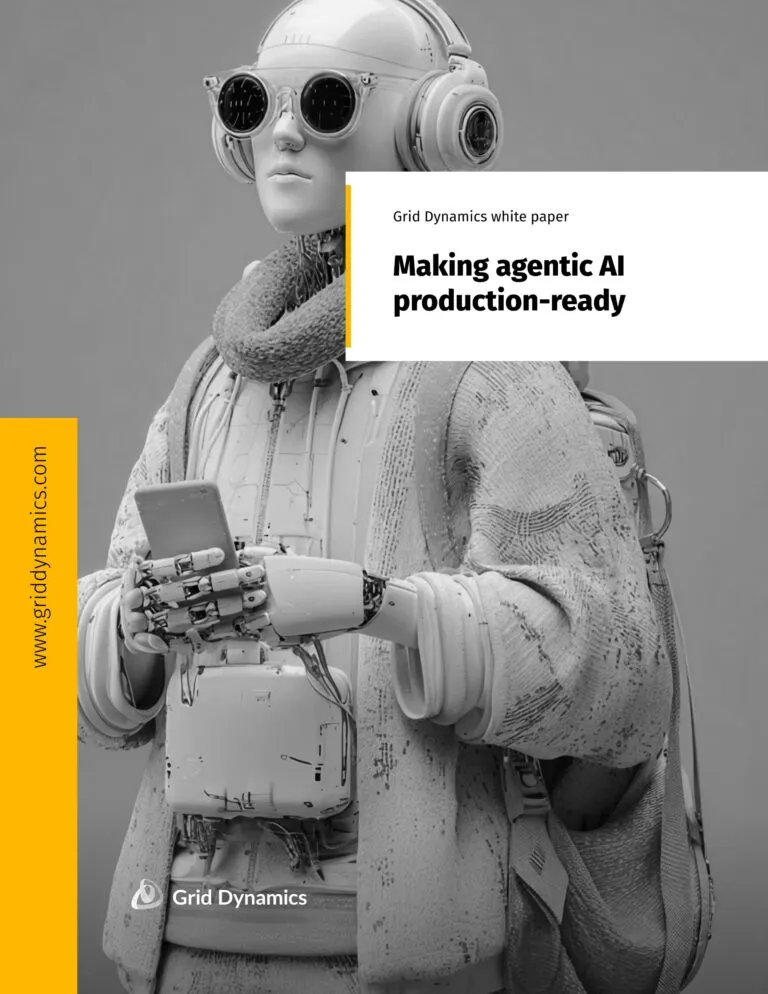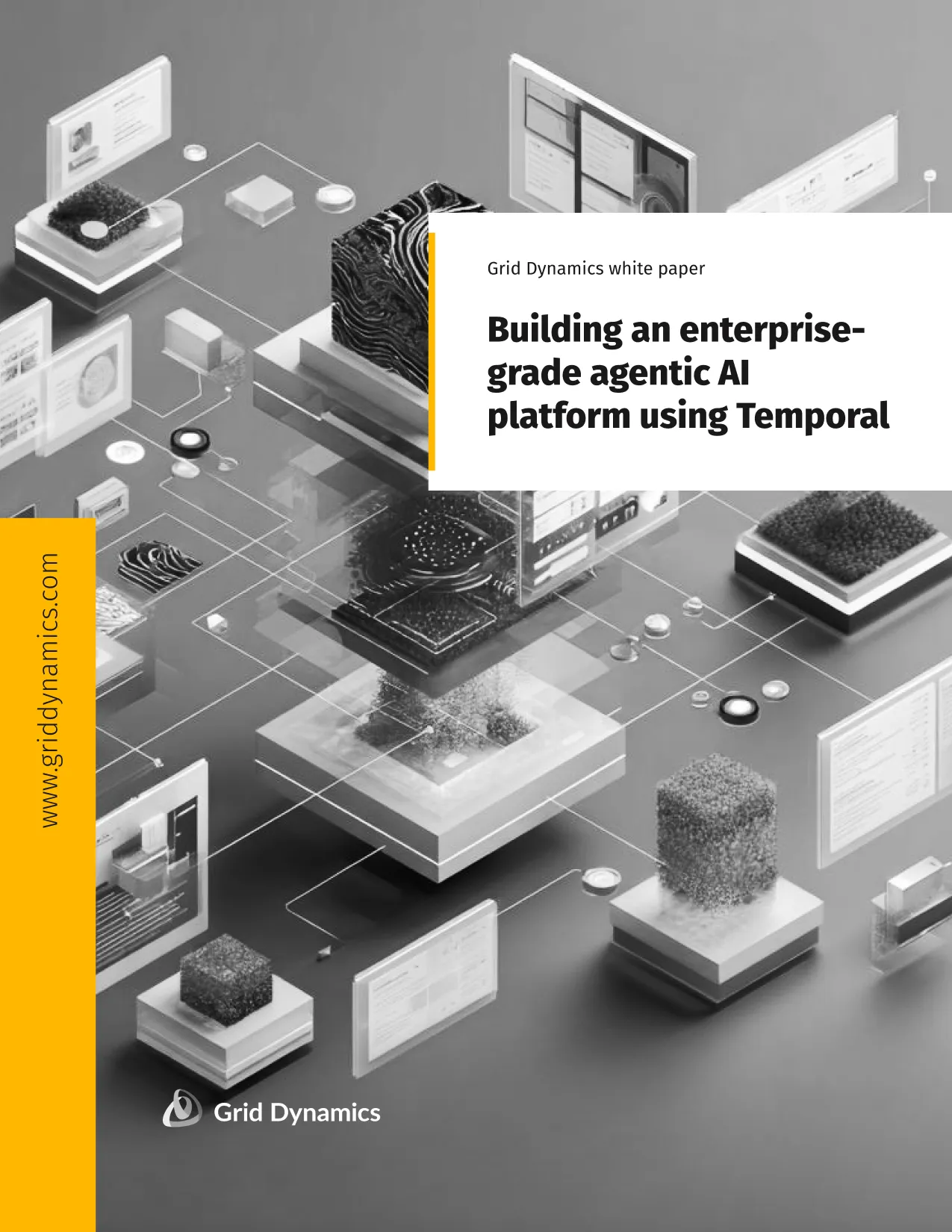Get the White Paper
CTO insights: Agentic AI

Executive summary
For technical leaders seeking a comprehensive understanding of Agentic AI technology—including architectural innovations, implementation frameworks, and detailed technical guidance—download the full white paper for an in-depth analysis, technical deep dive, and actionable strategies to accelerate your enterprise AI journey.
Agentic AI technology in a nutshell
Enterprises are under increasing pressure to scale knowledge work and reduce operational costs. How? By optimizing workflows, leveraging traditional and generative AI-driven automation, and improving compliance. But now they can take it a step further. Agentic AI helps enterprise leaders move beyond traditional rule-based automation, introducing autonomous reasoning and dynamic orchestration for enterprise systems.
Agentic AI represents the next phase of artificial intelligence. It autonomously plans and executes complex tasks through cycles of reasoning and action. Unlike traditional generative AI systems that simply respond to queries, create content, or follow instructions, AI agents can take initiative, understand objectives, interact with enterprise tools, learn from outcomes, and dynamically adjust their approaches—one step closer to human intelligence. For example, in customer service, an AI agent can expand simple question-answering to check a user’s outstanding balance, recommend accounts to pay it from, and complete the transaction when prompted—all while maintaining a natural conversation and adapting to unexpected inputs or requests.
Why now? Key drivers accelerating Agentic AI adoption
In the blink of an eye, we’ve fast-forwarded from early breakthroughs in scripted automation in the 1990s, structured process flow in the 2000s, robotic process automation (RPA) in 2010, AI assistants in the early 2020s, and now autonomous, problem-solving Agentic AI.

From here on out, we can expect the AI innovation pipeline to accelerate exponentially. The impetus on businesses to adapt to non-linear change is now stronger than ever, because failure to adapt means losing revenue and falling behind competitors—fast. Where previous AI implementations came with issues related to cultural change, mistrust, and implementation hurdles, with the latest wave of Agentic AI, competitive agility is boosted through the following features:
- Inference-time reasoning: AI models can dynamically decompose complex problems and verify solutions without retraining.
- Improved reliability: Agents augmented by tools and self-verification mechanisms provide better reliability and address hallucinations, omissions, attention deficit, and other common generative AI problems.
- Event-driven architecture: AI agents now orchestrate human workflows, IT systems, and real-time business processes.
- Enterprise tool integration: AI systems can securely connect with business applications, ensuring auditability and control. Economic pressures: Organizations seek automation solutions that reduce operational costs while improving efficiency.
Market momentum and strategic importance
Globally, the Agentic AI market, valued at $5.1 billion in 2024, is expected to reach $47.1 billion by 2030, representing a significant subset of overall generative AI spending. According to Gartner, by 2028, at least 15% of daily business decisions will be made autonomously through Agentic AI, while 25% of enterprise breaches will be tied to AI agent abuse. Organizations that proactively structure AI-human-agent collaboration will gain a competitive edge in intelligent process automation and knowledge work augmentation.
Enterprise benefits of agentic AI
The benefits of Agentic AI technology supercede traditional and generative AI, while also complementing them. Leveraging Agentic AI will help you optimize three core areas that dictate business success today:
- Transform operations: Automate knowledge-intensive processes while maintaining governance.
- Enhance decision-making: AI-driven reasoning augments human expertise and accelerates software development.
- Evolve customer experience: Shift from transactional interactions to goal-driven engagement with AI-driven orchestration.
Agentic AI adoption approach
As organizations explore Agentic AI adoption, understanding the capability progression from basic information retrieval to fully autonomous operations is critical for strategic planning. This evolutionary pathway represents a technology maturation curve and a practical implementation roadmap. Unlike traditional technology deployments that follow a ‘big bang’, all-at-once approach, Agentic AI capabilities are best implemented iteratively, allowing organizations to build necessary governance, skills, and trust while managing risk along the way. This phased evolution also enables enterprises to realize incremental value while developing the foundations for more advanced applications.

Strategic considerations for enterprises
As profoundly transformative as it is, Agentic AI is not a silver bullet. The right enterprise AI solutions can bridge the gap between experimentation and real-world impact, helping teams deploy agentic capabilities with confidence and control. Organizations must approach agentic AI as a tool for augmentation, not replacement. Success depends on defining AI governance frameworks for compliance and risk mitigation, modernizing IT infrastructure to support event-driven automation, developing operational models that blend AI-driven automation with human oversight, and ensuring data modernization for AI through structured documentation, real-time access patterns, and comprehensive governance frameworks.
By adopting a measured, strategic approach, enterprises can implement Agentic AI to drive automation, improve efficiency, and keep up with consumer expectations.
For in-depth technology analysis, technical architecture details, and actionable strategies, download the full white paper.
Tags
You might also like
Choosing the right agentic AI framework matters. Crew AI, Google ADK, LangGraph, and OpenAI Agents SDK each solve different problems, from rapid multi-agent prototyping to durable, stateful workflows and cloud-native enterprise agentic AI deployments. This comprehensive white paper examine...
As an enterprise leader, you’ve likely seen countless AI prototype demos over the last few years promising empty buzzwords like “transformation”, “efficiency”, and “competitive edge”. But how many of those prototypes actually work in production? Over the past decade, multiple AI hype cycles ha...
Running agent-based systems across your enterprise comes with tough problems. The main ones are keeping costs down, scaling up fast, and making sure nothing breaks when things go wrong. This white paper gets into the real challenges that come up when teams move from simple agent pilots to a ful...

Download this white paper for comprehensive details on how large-scale applications can overcome web application security risks and evolving web threats, including AI-driven attacks, supply chain vulnerabilities, and compliance pitfalls. It goes beyond traditional checklists for web applicati...
From performance and portability to real-world limitations, this white paper explores how WebAssembly (Wasm) is modernizing web development and its growing role in handling AI. Download the full WebAssembly white paper if you’re a frontend and full-stack developer, CTO or technical lead, D...
From retail to manufacturing, and from financial services to healthcare, every industry is eager to capitalize on the potential of artificial intelligence. But AI-ready data is essential to realizing that promise. To truly unlock that potential, AI solutions for enterprises must be built on a fou...
Delivering reliable software at speed is challenging. Even more challenging is continuing to rely on traditional quality assurance as digital transformation accelerates. Manual testing and conventional test automation simply can't keep up with the complexity and pace of modern development. Arti...










